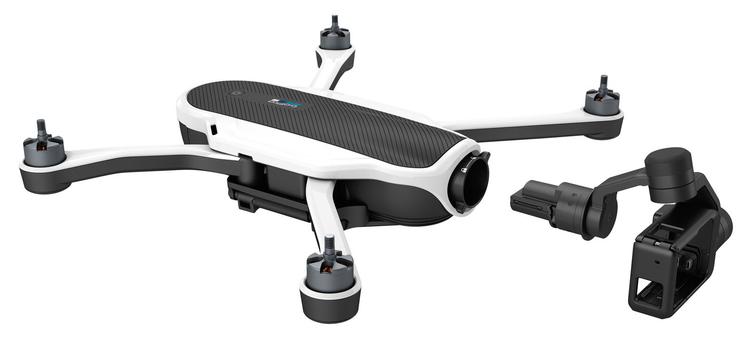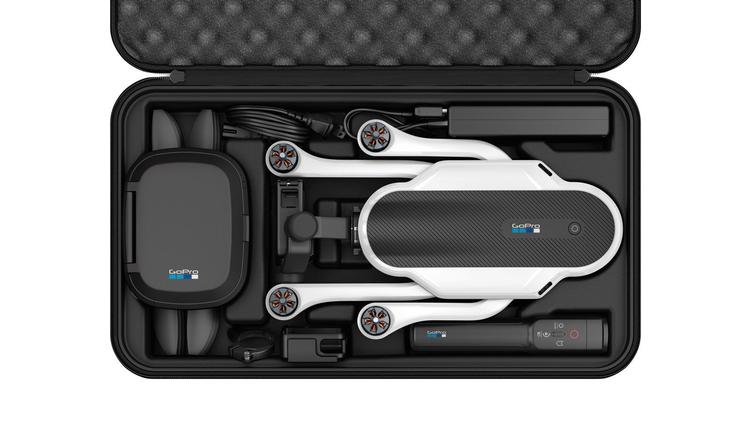On September 19th, GoPro launched the company’s first drone, the Karma. Our first impression was mixed, but now that the dust has settled we’re going to be taking a closer look at GoPro’s first step into the consumer market. During the grand unveiling, there was plenty of well-scripted talk from CEO Nick Woodman but not a whole load of substance. Here are the answers to the questions that most drone enthusiasts will be asking about the GoPro Karma.

First up, here are the technical specs
Maximum Speed: 35 mph (15 m/s)
Flight time: Up to 20 minutes
Maximum Distance/Range: 3280ft
Maximum Wind Resistance: 22mph
Operating Frequency: 2.4GHz
Dimensions (Opened/No Propellers): Length: 12in, Width: 16.2in, Height: 4.6in
Gimbal: 3-axis stabilizing
Price: $799
Does the GoPro Karma have autonomous flight modes?
Yes, but there’s a catch. The remote has one button for takeoff, landing, and a return to home function. It also has four preprogrammed shots: dronie, cable cam, reveal, and orbit. The GoPro Passenger app will also allow your pals to watch live video feed from the Karma and control the camera’s position.
However, there’s no Follow-me. This seems like a bit of an oversight on GoPro’s part, and maybe something that a software patch will add in the future. For all the talk of creating an “end-to-end life-capture solution” (Eurgh), releasing a drone that can’t even follow you will take some of the spontaneity out of your adventure.
Having said that, the Karma comes with a nifty looking remote control that’s been inspired by the gaming pads Xbox and Playstation users will be accustomed to. It’s got a built-in screen, so you could just take a friend with you to follow you down that mountain from above. Still, this is not ideal, and seems to go against the whole ‘get up and go’ philosophy that GoPro likes to talk about.
All in all, with GoPro directing the Karma at newcomers to the drone scene, we can expect that it’s going to be pretty straightforward to fly out of the box. But really that’s the bare minimum required of today’s mid level drones.
Is the GoPro Karma good value for money?
This is arguably where the Karma comes into its own. It’s hard to argue with the price of the full Karma bundle, even if the drone doesn’t have the top features needed to challenge at the top of the market.
Karma will go on sale on October 23rd, costing $799 for just the drone, $1,099 with a Hero 5, or $999 with a Hero 5 Session. The two 4K camera bundles offer really good value for money, particularly when compared to the cost of other extreme sports drones. Not to mention the fact that you’ll be essentially getting three bits of photography things in one: the drone, the ‘Grip’ stick and the camera. Add that to the remote and case thrown in, and it’s hard not to conclude that the price is Karma’s most redeeming feature.


How does the GoPro Karma measure up against the competition?
The Karma appears to be all about finding the right balance between capability and price. GoPro has leaned towards producing a value-for-money drone, so it’s only natural that in terms of specifications it doesn’t quite stack up against top of the range models from DJI and Yuneec. The lack of obstacle avoidance is a shame, but understandable given the kind of price GoPro wanted to market this at- You get what you pay for in this business. Both DJI’s Phantom and Yuneec’s Tyhoon H have some kind of collision avoidance tech, which makes a lot of sense when you want your drone to follow you on outdoor adventures. It remains to be seen how users will react to the Karma when this begins to cause problems.
The lack of a Follow-me mode – a feature that pretty much every other decent drone on the market has – is pretty baffling. This combined with a relatively short flight time of around 20 minutes seems to limit the GoPro Karma’s capability quite a bit.
But that’s the point really. GoPro isn’t trying to compete with the Tyhoon H or the Phantom 4. It’s set out to develop and dominate a new market of mid level photography quads. And if any company can do it, you’d have to think it’s GoPro. The huge amount of hype they were able to generate for the Karma, as well as the company’s huge global reach, will no doubt ensure that the orders come flying in. But even that market is soon to be competitive. DJI is rumored to be ready to release its new drone, the Mavic, in a move that could see the Karma’s positive first impressions blown out of the water. We’ll have to wait and see.
Yuneec already offers controllers with built-in displays and has a drone with a detachable gimbal, while DJI is ready to release its own foldable drone in a matter of days. With that in mind, the GoPro Karma will have to rely on the brand, as well as side products like its cloud storage subscription and a range of mounts and accessories.
Malek Murison is a freelance writer and editor with a passion for tech trends and innovation. He handles product reviews, major releases and keeps an eye on the enthusiast market for DroneLife.
Email Malek
Twitter:@malekmurison
Subscribe to DroneLife here.







Thanks , I’ve recently been searching for info approximately this subject
for ages and yours is the greatest I have discovered till now.
But, what about the bottom line? Are you positive concerning the supply?
Hello There. I discovered your weblog the use of msn. This is a really neatly written article.
I will be sure to bookmark it and return to read extra of
your helpful info. Thank you for the post.
I will definitely return.
It is missing alot of features that DJI and Yunec have in their drones, This is a slight epic fail from Go Pro in releasing a drone with limited functions, they had plenty of time to design a good drone